The Chinese Meteorological Society
Article Information
- DING Yihui, LIU Yanju, LIANG Sujie, MA Xiaoqing, ZHANG Yingxian, SI Dong, LIANG Ping, SONG Yafang, ZHANG Jin. 2014.
- Interdecadal Variability of the East Asian Winter Monsoon and Its Possible Links to Global Climate Change
- J. Meteor. Res., 28(5): 693-713
- http://dx.doi.org/10.1007/s13351-014-4046-y
Article History
- Received May 21, 2014;
- in final form July 28, 2014
2. Tianjin Climate Center, Tianjin 300074;
3. Beijing Meteorological Bureau, Beijing 100089;
4. Shanghai Climate Center, Shanghai 200030
The EAWM is a multi-scale phenomenon(Jin and Sun, 1996; Xu et al., 1999; Chan and Li, 2004; Pei and Li, 2007; Wei and Li, 2009). First, the EAWM varieson intraseasonal timescales. Frequent cold air outbreaks result in cold waves penetrating southward intoChina and cause severe winter weather(such as extremely low temperatures and /or blizzards). Intraseasonal oscillations in the strength of the EAWM arestrongest at periods of 30-60 days(quasi-40-day variability) and 10-20 days(quasi-2-week variability)(Lau and Lau, 1984; Pan and Zhou, 1985; Li, 1989c; Yang and Zhu, 1989; Lu, 1994; Chan and Li, 2004). Thestrong cold waves of 2004 and 2005 were prime examples of the influence of 10-20-day low-frequency variability of the EAWM. The 10-20-day low-frequencysignals propagate separately over the northern and southern Tibetan Plateau before coupling togetherwhile going around the Tibetan Plateau, leading tolarge-scale cold wave outbreaks(Ma et al., 2008).
Second, the EAWM varies on interannual timescales, with strong variability on quasi-2-, 4-, and 4-7-yr(or 5-8-yr)timescales(Guo, 1994; Mu and Li, 1999;Xu et al., 1999; Chen et al., 2000; Li et al., 2001;Chan and Li, 2004; Pei and Li, 2007; Huang et al., 2007b; Yan et al., 2009; Huang et al., 2012). The ElNiño-Southern Oscillation(ENSO)plays a significantrole in the interannual variability of the global atmospheric circulation. Over the last decade, a number ofstudies have revealed the strong influence of ENSO onthe EAWM(Li, 1989a, b, c; Zhang et al., 1996; Bueh and Ji, 1999; Mu and Li, 1999; Wang et al., 2000; Li et al., 2001; Chen, 2002; Chen et al., 2003; Huang et al., 2003; Wang et al., 2003; He et al., 2008; Zhang et al., 2008). The EAWM is generally weaker duringstrong El Niño events and stronger during strong LaNiña events. El Niño conditions trigger an anomalous anticyclone over the western Pacific and anomalous southerly winds in the lower troposphere, whileLa Niña triggers an anomalous cyclone over the western Pacific and anomalous northerly winds in the lowertroposphere in its western periphery, thus affecting theheat transport to South China(Chang and Lau, 1980;Tomita and Yasunari, 1996; Zhang et al., 1996; Ji et al., 1997; Wang et al., 2000; Wang and Zhang, 2002). The EAWM possesses different modes in the northern and southern parts of East Asia. The northernEast Asian cold winter mode appears when the EastAsian trough moves westward and the pressure in central Siberia deepens. By contrast, the southern EastAsian cold winter mode is associated with a deepeningEast Asian trough and higher pressures over Mongolia. The northern cold winter mode is closely relatedto the northeastern Siberian high and sea surface temperatures(SST)over the Atlantic and Indian oceans, while the southern cold winter mode is closely relatedto the development of La Niña and reduced snow coverover northeastern Siberia(Chen et al., 2014). Wanget al. (2010) and Wu et al. (2011)identified a thirdmode of the EAWM. Although this third mode onlyaccounted for 8. 7% of the variance, it played an important role in generating abnormally high snow and frost in southern China during 2007 and 2008. Thismode manifests as an increase in surface pressure overnortheastern East Asia and central Siberia, as well asa westward movement and intensification of the western Pacific subtropical high.
Third, the EAWM varies on decadal and interdecadal timescales, particularly the 9-10-, 20-30-, and 40-yr timescales. Although the derived results dependon the index used, most available indices measuringthe strength of the EAWM show that the EAWM has weakened since the mid 1980s(Xu et al., 1999; Wu and Wang, 2002; Yan et al., 2003; Chan and Li, 2004;Pei and Li, 2007; Shi et al., 2007; Zhu, 2008; Wang et al., 2010; He and Wang, 2012; He, 2013; Wang and Fan, 2013). This period represents the most pronounced weakening of the EAWM over the past 100years(i. e., the strongest warming in winter temperatures over East Asia). The weakening of the EAWMsince the mid 1980s may be attributable to a shiftin the dominant mode of the Arctic Oscillation(AO)from viewpoint of the atmospheric circulation(He and Wang, 2012). Recent studies have also shown thatdecadal variations in SST might alter the relationshipbetween ENSO and the EAWM(Wang et al., 2008;Ding et al., 2010), suggesting that the relationship between winter temperature over China and ENSO maybe important but complicated. The influence of ENSOon the EAWM is relatively weak during positive phasesof the Pacific decadal oscillation(PDO) and relativelystrong during negative phases of the PDO. Likely, thePDO is closely related to the EAWM, and may beconsidered as a bridge between air-sea interaction inthe midlatitude Pacific and that in the tropical Pacific(Zhou et al., 2007). PDO variability corresponds wellto simultaneous "seesaw" changes in the Aleutian low and Mongolian high, which result in zonal l and -seapressure differences that might significantly affect theintensity of the EAWM(Zhu and Yang, 2003; Yang et al., 2004; Zhou et al., 2007; Li et al., 2011).
The reduced rate of global warming during recent years has stimulated renewed interest in the relationships between anthropogenic climate change and natural climate variability. This renewed interest hasincluded increased attention to interdecadal variability of the EAWM. Liang et al. (2014)studied interdecadal variations in winter temperature and the regional circulation over mainl and China between 1960 and 2013. They reported strong interdecadal fluctuations superimposed on an overall warming trend inwinter temperature, which could be divided into threestages: a cold period, a warm period, and a hiatusperiod. These interdecadal changes in winter temperature are consistent with interdecadal variations in theEAWM. The present paper will therefore focus on theresults from recent studies on interdecadal variabilityof the EAWM with the aim to provide a more systematic underst and ing of the features and physical mechanisms of this interdecadal variabilitY and its relationships with global climate change. The remainder ofthis paper consists of four sections. Section 2 detailsthe climatic background state. Section 3 describes interdecadal variations in the EAWM. Section 4 presentspossible explanations for these interdecadal variations. Finally, Section 5 provides a synthesis and summary. 2. Climatic background: Impact of Global climate change
The global monsoon system is an important component of the climate system. Changes in the climatesystem due to changes in climate forcing will signifi-cantly affect the global monsoon system. This is particularly true for the enormous Asian monsoon system, which is driven primarily by the l and -sea thermal contrast. Figure 1a shows annual global mean temperature anomalies from 1850 to 2013. The global average temperature clearly rose during this period. Thiswarming trend was not monotonic, and included multiple scale fluctuations. For example, the time seriessince 1900 has included two cold phases(1900s-1920s and 1950s-1970s) and two warm phases(1930s-1940s and 1980s-1990s), suggesting a typical period of 40 yr. Global temperature observ ations became much morereliable around the 1950s(the shaded area representsthe uncertainty range). The 60-yr period covered bythese more reliable measurements included a cold period, a warm period, and a period of slowed warming(often called the "global warming hiatus")(Easterling and Wehner, 2009; Kerr, 2009; Knight et al., 2009). The effects of global warming are also apparent in thetime series oFannual mean surface temperature averaged over China from 1901 to 2012(Fig. 1b). Application of a low-frequency filter to this latter time seriesagain reveals two cold periods and two warm periodssuperimposed on a general warming trend. Relativeto the global mean time series, the second cold period had a longer duration over China(the 1950s-mid1980s rather than 1950s-1970s) and the second warm period also lasted slightly longer(to the mid 2000srather than the late 1990s).
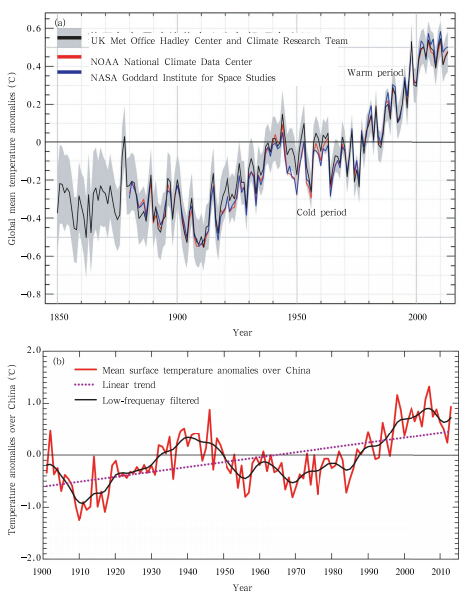 |
| Fig. 1. Annual surface temperature anomalies(℃)averaged over(a)the entire globe for 1850-2013(from the WorldMeteorological Organization Statement on the Status of the Global Climate in 2013, http://www. wmo. int) and (b)China for 1901-2013(from China Climate Change Monitoring Bulletin 2013). The global mean anomalies are calculatedrelative to the 1961-1990 mean, while those over China are calculated relative to the 1971-2000 mean. |
Wang and Chen(2014)showed significant negative anomalies in low-pass filtered winter temperature over East Asia before 1987 and after 2008 usinga variety of datasets(Fig. 2). Although the temperature anomalies through most of the early 2000s werenot negative, they were generally quite close to zero. These results indicate that changes in winter temperature over East Asia were closely related to changesin global mean temperature, even if they were notexactly simultaneous(winter temperature over EastAsia lagged behind global mean temperature by approximately 5 yr). Regional responses to climate forcing can be very heterogeneous under global warming. Global temperature changes affect regional circulationpatterns, which in turn affect regional temperatures, so the regional response may lag behind the global response.
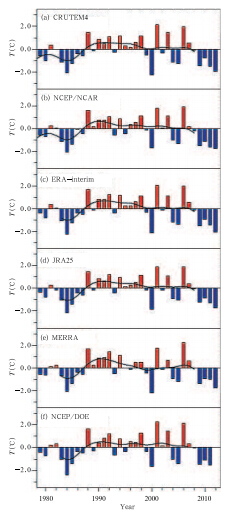 |
| Fig. 2. Winter mean surface air temperature anomalies(℃)averaged over East Asia(20°-60°N, 100°-140°E)based on a variety of datasets. The black solid lines denotea 9-yr low-pass-filtered time series with the Lanczos filter. [From Wang and Chen, 2014] |
The time series of average winter(December-February)temperature over China over 100 yr(1901-2012)has the same two cold and warm phases as thetime series oFannual mean temperature(Tang et al., 2012). In addition, despite the recent reduction in therate of warming in annual mean temperature, the winter temperature averaged over China has remained athigh level(Fig. 3a). By contrast, the winter air temperature over Northeast China has declined over thepast 10 years(Fig. 3b), suggesting that the stagnationof global warming over the past 10-15 years has beenmost pronounced over Northeast China. Decreasesin winter temperatures have also been observed overnorthern Xinjiang and Inner Mongolia. These changesin global temperature and temperature over China affect l and -sea thermal contrast and the winter atmospheric circulation, which both influence the EAWM. It is therefore necessary to analyze interdecadal variability of SST to gain an insight into their link.
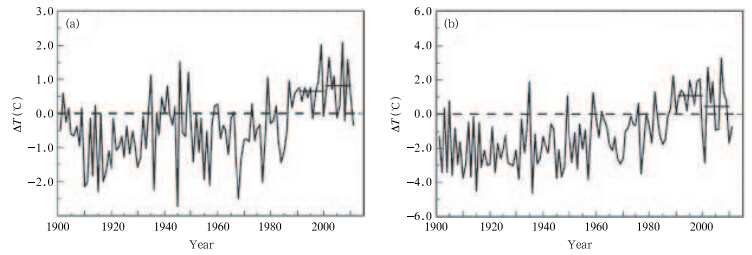 |
| Fig. 3. Winter temperature anomalies(℃)averaged over(a)China and (b)Northeast China. Anomalies are calculatedrelative to the 1971-2000 mean. Short solid lines show decadal mean anomalies during 1991-2000 and 2001-2010. [From Tang et al., 2012] |
Several recent studies have focused on interdecadal variations in the East Asian summer monsoon(Ding, 2007; Ding et al., 2013). The most pronouncedvariations occur on 60-80-yr timescales, and may reflect long-term oscillations in global air-sea interactions. The East Asian summer monsoon also varieson 44- and 22-yr periods.
SSTs in the large ocean basins experienced twoperiods of strong decadal warming during the 20thcentury. The first occurred in the late 1970s, whendecadal-scale warming of SSTs reached 0. 4-0. 6℃ incentral and eastern equatorial Pacific(roughly equivalent to the warming associated with a st and ard ElNiño event). Strong cold anomalies in North Pacificduring this same period were associated with weather and climate anomalies throughout the world(Ding, 2013). The second warming, which occurred before1997/98, was most pronounced in the North Atlantic and Indian oceans. SSTs in the central and easterntropical Pacific have declined during the 15 years after 1998, indicative of a negative phase of the PDO(Tollefson, 2014). The PDO, which has a significantimpact on the East Asian monsoon, caused warmingin the central and eastern tropical Pacific from thelate 1970s through 1998 followed by cooling after 1998. This cooling period has now lasted for 10-15 yr. Assuming a 40-yr periodic oscillation, the warming associated with the positive phase of the PDO may notreturn before 2020.
These interdecadal variations in SST over NorthPacific have significantly influenced the East Asianmonsoon, and hence the climate and weather in China. Variability in North Pacific SSTs can induce changesnot only in the strength of the summer monsoon and the "southern flood and northern drought" pattern ofprecipitation, but also in winter temperatures. Thesechanges can also affect the strength and latitudinal position of the EAWM(Ding, 2007; Wang et al., 2008;Deng et al., 2009). Interdecadal variations in theEAWM are therefore likely a manifestation of interdecadal variations in SST over North Pacific. However, differences in the response time and scope ofdifferent components of the climate system can causeregional differences in the timing and other characteristics of interdecadal variations over East Asia and North Pacific. 3. Interdecadal variability of the EAWM 3. 1 Variations of the winter monsoon over East Asia
The EAWM has experienced remark able interdecadal variations. The EAWM strengthened consistently from the 1950s through the 1970s, and thenweakened substantially after the mid 1980s. Researchers both within China and abroad agree that theweakening of the EAWM and Siberian high during recent decades may be attributable to global warming. Shao and Li(2012)assessed 20 different indices of theEAWM defined before 2009. Their results showed thatchanges and trends in the strength of the EAWM and related atmospheric circulation anomalies over EastAsia are generally consistent among various indicesbased on different aspects of the EAWM. Althoughthe timing of interdecadal changes and occurrence ofstrong or weak years obtained by using different indices may not completely agree, most of the indicesindicate that the EAWM has weakened since the mid1980s and that this has been the most pronounced reduction in the strength of the EAWM during the past100 years. This weakening period coincides with themost rapid warming of winter temperatures over EastAsia, and is largely consistent with trends in globalmean temperature(Xu et al., 1999; Wu and Wang, 2002; Pei and Li, 2007; Shi et al., 2007; Zhu, 2008;Wang et al., 2010; He and Wang, 2012; He, 2013;Wang and Fan, 2013).
The weakening of the EAWM after the mid 1980sappears to have ended, with observ ations indicatingthat the EAWM has strengthened during the early2000s(Figs. 4 and 5). Winter temperatures over EastAsia accordingly decreased, as described in the previous section(see Fig. 3). Interdecadal variations inthe EAWM over the past 60 years can be divided intothree periods: the period before the mid 1980s whenthe EAWM was relatively strong, the period from 1987to 2004 when the EAWM was relatively weak, and the period since 2005 during which the EAWM hasstrengthened again(National Climate Center, 2013;Liang et al., 2014; Wang and Chen, 2014).
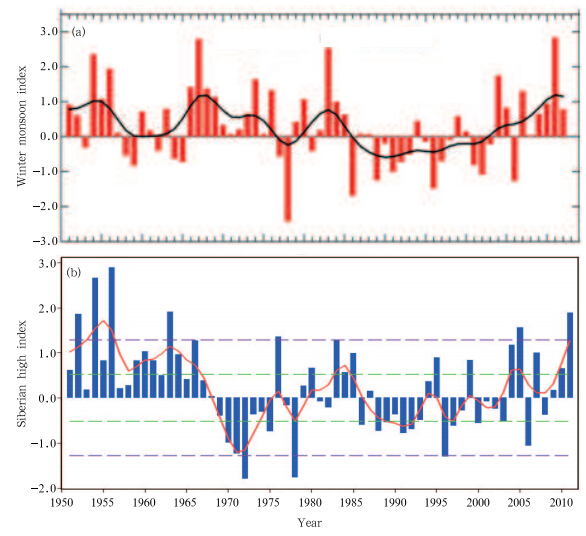 |
| Fig. 4. Temporal variations of East Asian winter monsoon indices between winter 1950/51 and winter 2012/13 from(a)China Climate Change Monitoring Bulletin 2013 and (b)China Meteorological Administration(http://cmdp. ncc. cma. gov. cn/extreme/lowtemp. php?product=lowtemp_diag). The black solid line in(a) and the red solid line in(b)denotethe Gaussian low-pass filtered time series. |
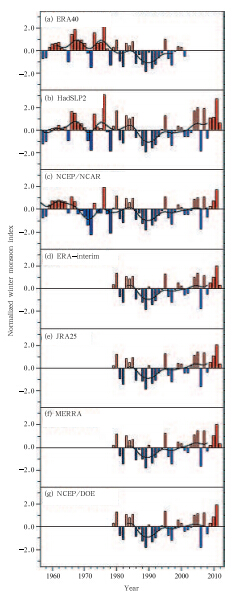 |
| Fig. 5. Normalized winter-mean East Asian winter monsoon indices calculated by using a variety of datasets. Theblack solid lines show the 9-yr low-pass Lanczos filteredtime series. [From Wang and Chen, 2014] |
The leading EOF mode of winter mean temperatures over China was a homogeneous warming with themaximum located north of 40°N(Fig. 6), suggestingstronger warming in the north than in the south(Kang et al., 2006; Liang et al., 2014). The st and ardizedtime coeffcient of this leading EOF mode indicates astrong linear warming trend superimposed on interdecadal variability. These variations are particularlyclear after a Gaussian low-pass filter is applied to thetime series. Winter temperatures in China changedsubstantially in the mid 1980s, with the winter of1986/87 as the approximate dividing line between cold and warm periods(Liu and Zheng, 2003; Song and Ji, 2005). The normalized time coeffcient of the leading EOF was negative during the cold period(indicating colder winter temperatures throughout China) and positive during the warm period(indicating warmerwinter temperatures throughout China). This normalized time coeffcient has declined since the winter of2006/07. This decline has coincided with decreases intemperature and increases in the frequent occurrenceof freezing rain, snow, and cold spells during winter inChina.
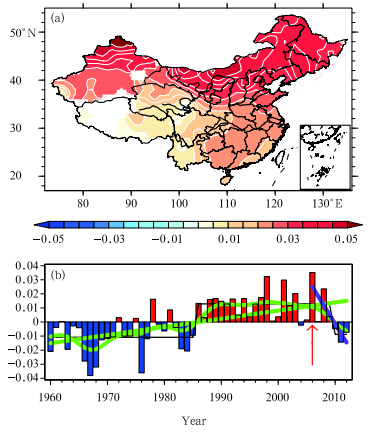 |
| Fig. 6. (a)Spatial pattern and (b)normalized time coefficient of the leading EOF mode of winter-mean 2-m airtemperature over mainl and China between 1960/61 and 2012/13. The colored bars in(b)show the st and ardizedanomaly, black solid line shows stepwise regime shifts in themean detected by the sequential method, green solid lineshows the linear trend, green dashed line shows the Gaussian low-pass filtered time series, purple solid line shows thelinear trend between winter 2006/07 and winter 2012/13, and red arrow indicates the winter of 2006/07. [From Liang et al., 2014] |
Several studies have further suggested that winter temperature in China has entered a new coldstage during recent years. Two recent studies haveproposed that variability in winter temperatures overChina can be divided into three stages(Liang et al., 2014; Wang and Chen, 2014). The cold period, whenthe EAWM was relatively strong, lasted from the winter of 1960/61 to the winter of 1985/86. Thewarm period, when the EAWM was relatively weak, lasted from the winter of 1986/87 to the winter of2005/06. The hiatus period, which has coincidedwith a strengthening of the EAWM, has lasted fromthe winter of 2006/07 through at least the winter of2012/13(Fig. 7). Most areas of China(with exception of the Tibetan Plateau)experienced colder temperatures during the cold period. The distribution oftemperature anomalies during the warm period wasexactly opposite, with warm temperatures over mostof China(especially north of 35°N) and relatively coldtemperatures over the Tibetan Plateau. The distribution of temperature anomalies during the hiatus period resembles that during the cold period, but the magnitude of the temperature decrease north of 35°N hasbeen larger than that during the cold period, whilethe warming over the Tibetan Plateau has been muchstronger than that during the cold period. The increase in the highest temperatures has been particularly remark able. The strong cooling in winter overChina during the hiatus period is consistent with thedecadal changes in winter temperature presented by Tang et al. (2012)(Fig. 8). Although the overalltemperature during the hiatus period was higher thanthat during the cold period, the detrended temperature anomalies indicate a stronger reduction in temperature during the hiatus period than during the coldperiod. This result highlights the mutual influencesoFanthropogenic warming and natural variability onwinter climate over China. Detrended temperatureanomalies over the Tibetan Plateau were very different from those over other areas of China during thesethree periods. The reasons for these differences needfurther investigations.
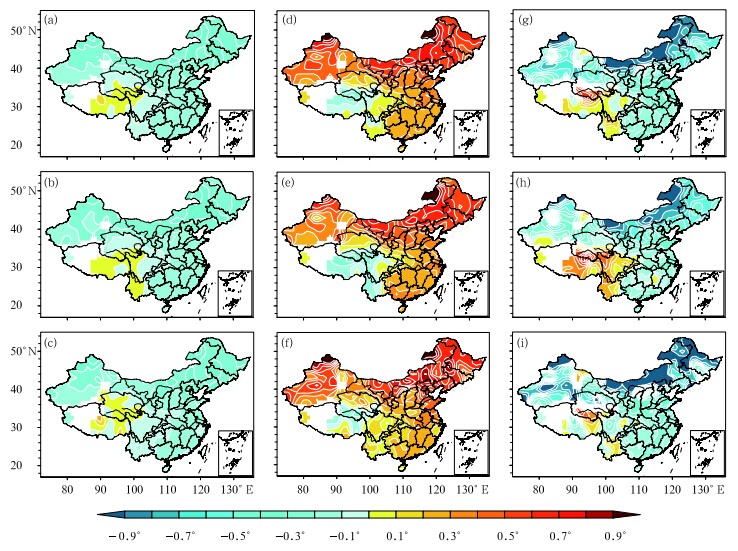 |
| Fig. 7. Distributions of detrended winter mean anomalies(℃)in(a, d, g)daily temperature, (b, e, h)daily maximumtemperature, and (c, f, i)daily minimum temperature during the(a-c)cold period, (d-f)warm period, and (g-i)hiatusperiod. |
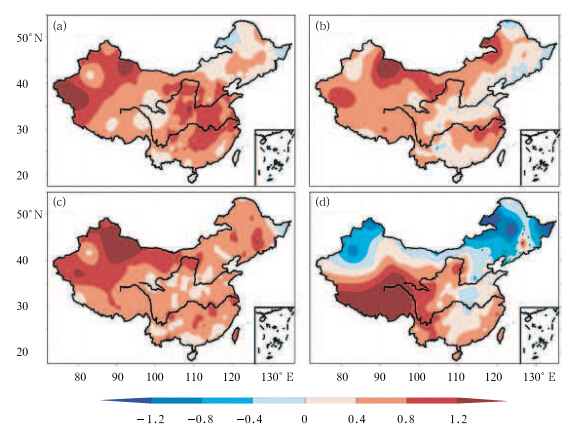 |
| Fig. 8. Temperature changes over China from 1991-2000 to 2001-2010 during(a)spring, (b)summer, (c)autumn, and (d)winter. [From Tang et al., 2012] |
The long-term trend toward a weaker EAWM overthe past 60 years has coincided with reductions in theintensitY and frequency of cold waves in China. Coldwaves happened frequently during the 1950s, with anaverage frequency of 5. 4 cold waves in China per year. The frequency of cold waves declined slightly in the1960s, and this reduction became more pronouncedduring the 1970s and 1980s. The occurrence frequencyof extreme warm temperatures increased during thisperiod, while the occurrence frequency of extreme coldtemperatures decreased. These variations were consistent with the weakening trend of the EAWM sincethe 1980s, which numerous studies have attributed toglobal warming(Ding and Sikka, 2006; Wei, 2008;Chen et al., 2013). The EAWM has strengthened over the most recent 10-15 years; this strengthening hascoincided with increases in both the frequencY and intensity of cold waves. 3. 3 Variations in the atmospheric circulation
The cold Siberian high dominates the mid and high latitudes of the Asian continent during winter(Ding and Krishnamurti, 1987). Sea level pressureanomalies during the warm period were approximatelyopposite to those during the cold period, while thoseduring the hiatus period were similar to those duringthe cold period(Figs. 9a-c). During the cold period, sea level pressure anomalies were positive over a largearea north of 45°N and negative over most areas southof 45°N. The positive anomalies, which extended fromGreenl and to the Ural Mountains in northern Eurasia, favored stronger northerly winds over Eurasia and enhanced transport of cold air from high latitudes tomid and low latitudes. During the warm period, sealevel pressure was relatively low over mid and highlatitudes and relatively high over mid and low latitudes. China therefore experienced stronger transportof warm air from mid-low latitudes, which then ledto warmer temperatures. The distribution of sea levelpressure anomalies during the warm period reducedthe strength of both the trough and the ridge thatdeveloped over East Asia during winter, indicating asignificant reduction in the strength of the EAWM. During the hiatus period, a strong positive sea levelpressure anomaly developed over Eurasia(from theEast European Plain cross the West Siberian Plain tothe Altai Mountains), significantly strengthening theSiberian high. These conditions were conducive forcold air intrusions into China, and led to significantfall in winter temperature.
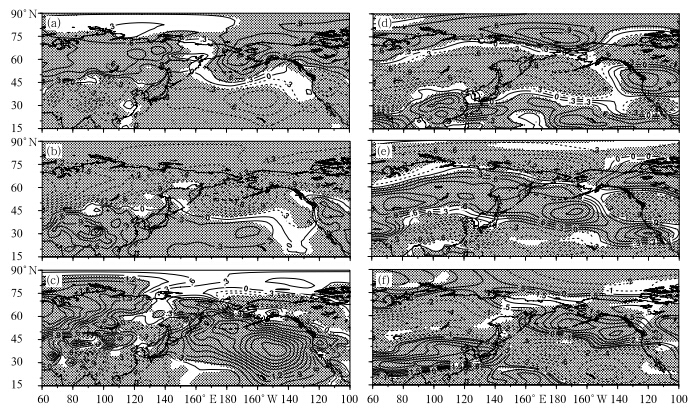 |
| Fig. 9. Composite seasonal mean anomalies of sea level pressure(hPa) and 300-hPa zonal wind(m s-1)during winterof the(a, d)cold period, (b, e)warm period, and (c, f)hiatus period. The grey stippling indicates statistical significanceat the 95% confidence level. [Modified from Liang et al., 2014] |
The strength of the EAWM is also reflected in theintensity of the upper-level jet stream over East Asia(Jhun and Lee, 2004). The intensity of the upper-leveljet averaged over the area 27. 5°-37. 5°N, 110°-170°Ewas stronger during the cold period and weaker during the warm period(Figs. 9d-e). By contrast, theintensity of the upper-level jet averaged over the area50°-60°N, 80°-140°E was weaker during the cold period and stronger during the warm period. Both ofthese changes are consistent with a stronger EAWMduring the cold period than during the warm period. The distribution of 300-hPa zonal wind anomalies during the hiatus period has many similarities with that during the cold period, indicating a strongerEAWM; however, the distribution was oriented withnorthwest-southeast tilting rather than zonally(Fig. 9f). This indicates a northward shift in the EAWMsystem. The zonal wind anomalies during the cold, warm, and hiatus periods are consistent with variations in the Northern Hemisphere annular mode(NAM) and Arctic Oscillation(AO) and will be discussed further in the following section.
The East Asian major trough is an importantcomponent of the mid-tropospheric circulation in thewintertime Northern Hemisphere. The strength of thistrough also reflects the strength of the EAWM. Duringthe cold period, 500-hPa geopotential height anomalies were positive in the north and negative in thesouth(Fig. 10a). The positive anomalies were centered near the Ural Mountains and the Bering Strait, while the strongest negative anomalies over East Asiawere located over North China, the Korean Peninsula, and southern Japan. The patterm of these anomaliesstrengthened the trough and ridge system over EastAsia. The deepening of the trough was particularlypronounced. Downward motion over the Siberian area and the southward transport of cold air from highlatitudes were both relatively strong, with northerlywinds prevailing in the mid troposphere over mainl and China. The anomalies in 500-hPa geopotential heightduring the warm period were opposite to those duringthe cold period, with negative anomalies in the north and positive anomalies in the south(Fig. 10b). Thisled to a more zonal circulation in mid and high latitudes, which inhibited the southward propagation ofcold air from high latitudes. By contrast, the northward transport of warm air from low latitudes wasrelatively strong. These changes in temperature advection together led to warmer winter temperatures. During the hiatus period, the negative anomaly in 500-hPa geopotential height over Eurasia was located overthe Lake Baikal and the region to its west, while thepositive anomaly was located over North Pacific(Fig. 10c). Downward motion over the Siberian region wasweaker during this period than during the cold period. The decrease in temperature and the increase in theoccurrence frequency of cold waves during the hiatusperiod occurred mainly over northern areas. According to the quasi-geostrophic relation, changes in the geopotential height field are accompanied by changesin the wind field. The East Asian trough is thereforeclosely related to the EAWM, and these phenomenacombine together to influence winter temperatures inChina.
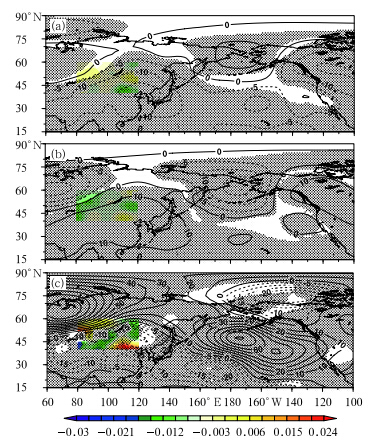 |
| Fig. 10. Composite seasonal mean geopotential height(gpm) and vertical velocity(shaded; 0. 01 Pa s-1)anomalies at 500 hPa during winters of the(a)cold period, (b)warm period, and (c)hiatus period. The grey stipplingindicates values significant at the 95% confidence level. [Modified from Liang et al., 2014] |
Anomalies in the EAWM are associated with acomplex circulation system that is composed of multiple components. Both anthropogenic warming and natural climate variability affect the strength and variability of the EAWM. Natural variability in the oceancan cause the development of atmospheric circulation anomalies via air-sea interactions, particularlythe anomalies in fluxes of sensible and latent heat. These circulation anomalies affect the winter monsoon, and vice versa. Large-scale coupled atmosphereocean variability is therefore a very important factorin the development and variability of the EAWM.
Mainl and China is adjacent to North Pacific, and is therefore profoundly influenced by SST anomalies inNorth Pacific. North Pacific SST experiences stronginterdecadal variability(Fig. 11a1), which is dominated by the PDO. The SST of North Pacific warmedsubstantially from the mid and late 1970s through theend of the 20th century, associated with both the positive phase of the PDO and global warming(Fig. 11a2). The PDO changed to the negative phase during thewinter of 2005(Tollefson, 2014). Previous studies haveindicated that interdecadal variations of SST in NorthPacific substantially influence the East Asian monsoon and climate in China(Li and Xian, 2003; Wang et al., 2007; Wang et al., 2008). Figure 11b shows low-passfiltered time series of the EAWM index(Zhu, 2008) and the PDO index during winter. The EAWM index and the PDO index are negatively correlated(correlation coeffcient -0. 55)at the 99% confidence level. This correlation is consistent throughout China, and is particularly strong in northern China. Furthermore, the most significant correlation is with the daily minimum temperature in winter(figure omitted). On theinterdecadal scale, the timing of the transition fromnegative to positive PDO(1978) led the shift in theEAWM(1987; see Section 2).
 |
| Fig. 11. Time series of(a1)the PDO index and (a2)annual global mean temperature anomalies(℃)relative to the1961-1990 mean(from Tollefson, 2014), and (b)low-pass filtered East Asian winter monsoon index and winter PDOindex. |
The EAWM index is also negatively correlatedwith the AO index. The AO influences the wintermonsoon by altering the large-scale circulation pattern over Eurasia, the position and strength of thejet stream, and the strength of the Siberian high(Gong et al., 2002; Wu et al., 2004; Liang et al., 2014). The weakening of the EAWM since the mid1980s may be associated with the simultaneous enhancement of the AO(He and Wang, 2012). Changesin the NAM have been associated with interannual and interdecadal variations of East Asian climate viatheir influences on quasi-stationary planetary waves, and can cause changes in the EAWM by influencingthe strength of the Siberian high during winter(Wu and Huang, 1999; Gong et al., 2001; Chen and Kang, 2006). Wei and Li(2009)showed that the negativephase of the NAM/AO is associated with a weakeningof the westerly jet, a deepening of the East Asian trough, a strengthening of the downward motion behind the East Asian trough, and a strengthening ofthe Siberian high. The southeastward movement orextension of the Siberian high strengthens the EAWM and increases the occurrence frequency of cold air outbreaks in China. The positive phase of the NAM/AOis associated with the opposite distribution of circulation anomalies, and therefore warmer winter temperatures in China.
Liang et al. (2014)showed that the variance contributions of the NAM/AO were 8. 01% on timescalesof 15-25 yr and 21. 16% on timescales of 40-60 yr, respectively. For comparison, the leading EOF mode ofwinter minimum temperature accounted for 1. 44% ofthe variance on timescales of 15-25 yr and 21. 16% ofthe variance on timescales of 40-60 yr. These resultsare consistent with those of Wallace(2000), who reported that the NAM/AO could explain around 30%of the warming signal in global mean temperature. The correlation coeffcient between the mean winterNAM/AO index and the normalized time coeffcient ofthe leading EOF of winter temperature in China was0. 75. This correlation coeffcient remained relativelyhigh(0. 43)even when the 10-yr low-pass filter wasnot applied. Both correlation coefficients are signifi-cant at the 95% confidence level. The correlation coeffcient between the PDO index and the leading EOFof winter temperature in China was 0. 45 without thelow-pass filter. Variations in the PDO index led variations in winter temperatures over China, with a maximum correlation coeffcient(0. 71)at a lead time of 6yr. Decomposition indicates good agreement betweenthe normalized time coeffcient of the leading EOF ofwinter minimum temperature and the NAM/AO index in winter on timescales of 15-25 and 40-60 yr. The NAM/AO index slightly led the normalized timecoeffcient of the leading EOF on timescales of 15-25yr during the cold period, while the two time serieswere nearly in phase during the warm period. Afterthe winter of 2000, the normalized time coeffcient of the leading EOF slightly led the NAM/AO index on15-25-yr timescales. By contrast, the NAM/AO index slightly led the normalized time coeffcient of theleading EOF on timescales of 40-60 yr, with relatively good agreement throughout the data record. The 40-60-yr NAM/AO index began to decline in2000, while the 15-25-yr NAM/AO index shifted toa negative phase in 2006. Both time series indicate atransition to the negative phase of the NAM/AO between 2000 and 2005. This transition indicates a shiftin the Northern Hemisphere circulation from a zonalcirculation to a meridional one, with more frequentcold air outbreaks and lower winter temperatures inChina. The normalized time coeffcient of the leading EOF also declined around this time. This resultfurther highlights the close relationships between theNAM/AO and winter temperatures in China on thesetwo timescales. In other words, the NAM/AO substantially influenced winter temperatures in China oninterdecadal timescales via its effects on the EAWM, particularly on timescales of 15-25 and 40-60 yr.
Studies have suggested that the PDO can modulate the correlation between ENSO and the atmospheric circulation, so the relationship between ElNiño/La Niña events and winter temperature in Chinamay not be linear. Different relationships betweenENSO and the EAWM, and ENSO and winter temperature in China have been observed during differentphases of the PDO(Wang et al., 2008). The correlation between ENSO and the EAWM was strong and negative when the PDO was in the negative phase before the mid 1970s. By contrast, there was no correlation between ENSO and the EAWM when the PDOwas in the positive phase after the mid 1970s(Wang and Fan, 2013; Wang and He, 2013). The results ofthese studies indicate that the influence of ENSO onthe EAWM is not stable, and is modulated by variations in North Pacific SST on decadal timescales. Theshift to a positive PDO in 1978 may be an importantreason behind the weak response of the atmosphericcirculation over Asia to ENSO(Wang et al., 2008).
Liang et al. (2014)further investigated differencesin the influences of ENSO and the AO on the EAWMunder different phases of the PDO. Figure 12 showsthat the interdecadal signals of the NAM/AO and thePDO were predominantly in the negative phase during the cold period and predominantly in the positivephase during the warm period. Both time series returned to the negative phase during the hiatus period. Both the PDO and the NAM/AO transformed to thenegative phase at the start of this century, consistentwith a drop in winter temperature over China(EOF1 and EOF2) and an increase in the frequency of coldENSO(La Niña)events.
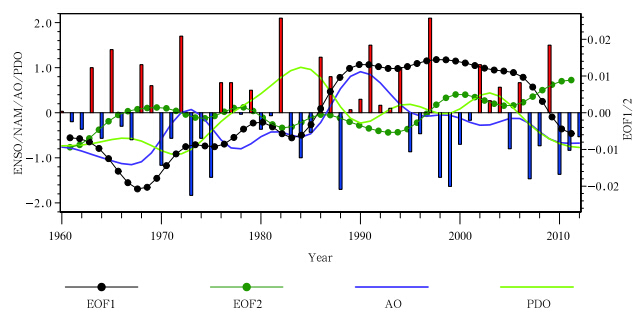 |
| Fig. 12. Temporal variations of ENSO index(bars) and 11-yr running means of the NAM/AO index(purple solid line) and PDO index(light green solid line), and normalized time coefficients of the first(black line) and second(dark greenline)EOF modes of winter mean temperature over mainl and China(lines with filled circles). [From Liang et al., 2014] |
Further analysis indicates differences in theEAWM circulation under different combinations of NAM/AO and ENSO that can be modulated by thePDO(Liang et al., 2014). When the NAM/AO and ENSO were both in the positive phase, the East Asiancirculation was characterized bYanomalous southerlywinds, a weaker East Asian trough, and warmer wintertemperatures in China. By contrast, when both theNAM/AO and ENSO were in the negative phase, theEast Asian circulation was characterized bYanomalous northerly winds, a deeper East Asian trough, frequent southward cold air outbreaks, and colder winter temperatures in China. The atmospheric circulation pattern over Eurasia associated with interdecadalvariations in the PDO and the NAM/AO was similar. T eleconnection patterns associated with interannual variability in the ocean mainly influenced thecirculation over the eastern North Pacific and NorthAmerica, with only small effects on the circulation overEurasia(especially in mid and high latitudes). Theseresults indicate that interdecadal variations in the circulation over Eurasia were mainly attributable to thePDO, while variations in the circulation over the eastern North Pacific and North America were mainly attributable to interannual signals(e. g., ENSO). Interdecadal variations in winter temperature over mainl and China were primarily influenced by interdecadalvariations in the NAM/AO and PDO, with the effects of ENSO manifested mainly in interannual northsouth oscillations in winter temperature anomalies.
To summarize, the interdecadal variations of winter temperature in China were profoundly influencedby oscillations and variations in the atmospheric circulation and the SST distribution in North Pacific. Figure 13 shows a schematic diagram of the general features and flow patterns during the cold and warm periods. The NAM/AO was in the negativephase during the cold period. Upper-level zonal windswere relatively weak in mid and high latitudes, theEast Asian trough was relatively deep, the Siberianhigh was relatively strong, and the 850-hPa meridional wind anomaly over China was northerly. SSTin North Pacific was typical of the negative phase ofthe PDO, and an anomalous cyclone appeared at 850hPa over the eastern part of the Philippines. Theseconditions increased the southward transport of coldair from high latitudes into China, and resulted in relatively cold winters. By contrast, the NAM/AO wasin the positive phase during the warm period, withstronger upper-level zonal winds, weaker East Asiantrough and Siberian high, and southerlYanomaly at850 hPa over China. The PDO was in the positivephase, with an anomalous anticyclone at 850 hPa overthe eastern part of the Philippines. These conditions enhanced the northward transport of warm and moistair from low latitudes and inhibited the southwardtransport of cold air from high latitudes, and resultedin relatively warm winters in China.
 |
| Fig. 13. Schematic diagrams depicting the characteristics and circulation patterns during(a)cold and (b)warmperiods. The black thick lines represent the 5200-gpm(northern) and 5300-gpm(southern)contours of geopotentialheight. Shaded ellipses represent the East Asian trough, with red(blue)shading indicating higher(lower)geopotentialheight values relative to the climatological mean. Shaded boxes represent the Siberian high, with red(blue)indicatinghigher(lower)values relative to the climatology. The blue arrow in(a) and the red arrow in(b)indicate directions of themean zonal wind anomalies. Purple arrows represent wind anomalies at 850 hPa. The yellow arrow represents anomaliesin vertical velocity, with downward arrow indicating stronger downdrafts. The green contour separates positive SSTanomalies from negative ones. The green curved arrow indicates the anomalous 850-hPa cyclone(anticyclone)duringthe cold(warm)period. Red(blue)shadings in the polar region indicate positive(negative)SLP anomalies correspondingto a negative(positive)NAM/AO index. [From Liang et al., 2014] |
The mean distribution of SST over the last 10-15 years(Fig. 14a)is consistent with the conceptualmodel of interdecadal variations in the EAWM presented in Fig. 13. In particular, the mean SST over theequatorial Pacific during the last 10-15 years was typical of La Niña, consistent with more La Niña eventsthan El Niño events over the past 13 years(Fig. 14b). Meanwhile, the SST distribution in North Pacific wastypical of the negative phase of the PDO, which favors a stronger EAWM and reduces warming over EastAsia.
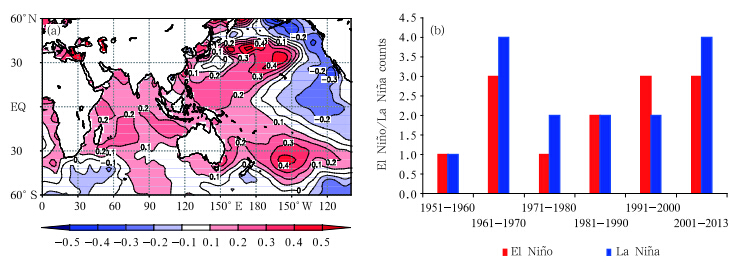 |
| Fig. 14. (a)Distribution of mean winter sea surface temperature anomalies(℃)averaged over 2001-2012. (b)Decadalcounts of El Niño and La Niña events between 1951 and 2013. |
This paper has reviewed the studies on interdecadal variability of the EAWM conducted duringrecent years. The results of the research in this aspectcan be summarized as follows.
(1)The EAWM has been significantly affected byglobal climate change. Winter temperature over Chinahas experienced three stages since the beginning of the1950s: a cold period(from the beginning of the 1950sto the early or mid 1980s), a warm period(from theearly or mid 1980s to the early 2000s), and a hiatusperiod(from 1998 to the present). The EAWM hasalso varied in three stages. The winter monsoon wasrelatively strong before the winter of 1986/87, relatively weak from 1987/88 through 2004/05, and hasstrengthened since 2005.
(2)The atmospheric circulation over East Asia, the winter mean temperature, and the occurrence ofcold waves in China have all experienced similar interdecadal variations. The upper-level zonal circulation was stronger, the mid-tropospheric trough overEast Asia was deeper with stronger downdrafts behindthe trough, and the Siberian high was stronger duringthe cold period than during the warm period. Thesechanges resulted in a stronger EAWM with more frequent cold air outbreaks during the cold period and aweaker EAWM with less frequent cold air outbreaksduring the warm period.
(3)Interdecadal variations in the EAWM appear to be closely related to interdecadal variationsin the atmospheric circulation and the regional distribution of SST over the Pacific Ocean. The EAWMwas stronger during negative phases of the NAM/AO and PDO, and weaker during positive phases of theNAM/AO and PDO. Winter temperatures over Chinawere therefore colder during negative phases of theNAM/AO and PDO than during their positive phases.
The Atlantic multidecadal oscillation(AMO)mayalso have important effects on the EAWM. The negative phase of AMO corresponded to colder winter temperatures and a stronger winter monsoon, while thepositive phase of AMO corresponded to warm wintertemperatures and a weaker winter monsoon.
Thus, the AMO is strongly correlated with interdecadal variations in the East Asian monsoon. TheAMO refers to quasi-periodic SST anomalies in theNorth Atlantic Ocean. This oscillation occurs onbasin-wide spatial scales with a period of 65-80 yr(Kerr, 2009). Several studies have suggested thatthe positive(warm)phase of the AMO correspondsto a weaker EAWM and warm winter temperaturesover most of China(Qu et al., 2006; Li and Bates, 2007; Yan et al., 2008; Li et al., 2009; Wang et al., 2009b). The significant warming of winter temperatures in China since the mid 1990s may be related toa combination of the warm phase of the AMO and global warming due to anthropogenic greenhouse gasemissions. The warming trend in winter temperaturesover China slowed down with the advent of the negative(cold)phase of the AMO(Li and Bates, 2007; Li et al., 2009). Figure 15 shows the detrended time evolution of mean winter temperature over China and theAMO index during winter. The negative(cold)phaseof the AMO corresponded to lower winter temperatures and stronger winter winds over China, while thepositive(warm)phase corresponded to higher wintertemperatures and weaker winter winds over China;however, changes in the AMO and changes in winter temperatures over China were not completely inphase. Although the AMO exerts an important influence on winter temperature in China, its role relativeto that of the PDO requires further investigations.
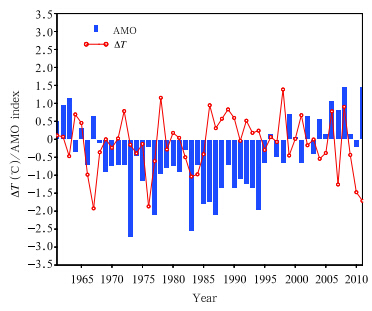 |
| Fig. 15. Detrended time series of winter mean temperature anomalies(red line; ℃) and winter AMO index(bluebars; ℃)from 1961 to 2010. The AMO index is calculatedas the SST anomaly averaged over North Atlantic(0°-60°N, 0°-80°W)by using the method proposed by Trenberth and Dennis(2006). |
Interdecadal variations in the ocean may therefore be regarded as one of the most important naturalfactors influencing the variability of the EAWM onlong timescales, although global warming may havealso played a significant role in weakening the EAWM.
| Bueh Cholaw and Ji Liren, 1999: Anomalous activity of East Asian winter monsoon and the tropical Pacific SST. Chin. Sci. Bull., 44, 890-898. |
| Chan, J. C., and C. Y. Li, 2004: The East Asian winter monsoon. East Asian Monsoon. Chang, C. P., Ed., World Scientific, Singapore, 54-106. |
| Chang, C. P., and K. M. Lau, 1980: Northeasterly cold surges and near-equatorial disturbances over the winter MONEX area during December 1974. Part II: Planetary-scale aspect. Mon. Wea. Rev., 108,298-312. |
| —-, and —-, 1982: Short term planetary scale interaction over the tropics and the midlatitudes during northern winter. Part I: Contrast between active and inactive periods. Mon. Wea. Rev., 110, 933-946. |
| Chen, W., M. Takahashi, and H. F. Graf, 2003: Interannual variations of stationary planetary wave activity in the northern winter troposphere and stratosphere and their relations to NAM and SST. J. Geophys. Res., 108, doi: 10.1029/2003JD003834. |
| Chen Wen, 2002: Impacts of El Niño and La Niña on the cycle of the East Asian winter and summer monsoon. Chinese J. Atmos. Sci., 26, 595-610. (in Chinese) |
| —-, H. F. Graf, and Huang Ronghui, 2000: The interannual variability of East Asian winter monsoon and its relationship to summer monsoon. Adv. Atmos. Sci., 17, 48-60. |
| —- and Kang Lihua, 2006: Linkage between the Arctic Oscillation and winter climate over East Asia on the interannual timescale: Roles of quasi-stationary planetary waves. Chinese J. Atmos. Sci., 30, 863-870. (in Chinese) |
| Chen Shangfeng, Chen Wen, and Wei Ke, 2013: Recent trends in winter temperature extremes in eastern China and their relationship with the Arctic Oscillation and ENSO. Adv. Atmos. Sci., 30, 1712-1724, doi: 10.1007/s00376-013-2296-8. |
| Chen, Z., R. G. Wu, and W. Chen, 2014: Distinguishing interannual variations of the northern and southern modes of the East Asian winter monsoon. J. Climate, 27, 835-851, doi: 10.1175/JCLI-D-13-00314.1. |
| Deng Weitao, Sun Zhaobo, Zeng Gang, et al., 2009: Interdecadal variation of summer precipitation pattern over eastern China and its relationship with the North Pacific SST. Chinese J. Atmos. Sci., 33,835-846. (in Chinese) |
| Ding, R., K. Ha, and J. Li, 2010: Interdecadal shift in the relationship between the East Asian summer monsoon and the tropical Indian Ocean. Climate Dyn., 34, 1059-1071. |
| Ding, Y. H., 1994: Monsoons over China. Kluwer Academic Publishers, Dordrecht/Boston/London, 419 pp. |
| —-, 2007: The variability of the Asian summer monsoon. J. Meteor. Soc. Japan, 85B, 21-54. |
| —-, and T. N. Krishnamurti, 1987: Heat budget of the Siberian high and the winter monsoon. Mon. Wea. Rev., 115, 2428-2449. |
| —-, and D. R. Sikka, 2006: Synoptic systems and weather. The Asian Monsoon. Wang, B., Ed., Praxis Publishing, Hong Kong, 131-201. |
| Ding Yihui, 2013: China Climate. China Science Press, Beijing, 557 pp. (in Chinese) |
| —-, Sun Ying, Liu Yunyun, et al., 2013: Interdecadal and interannual variabilities of the Asian summer monsoon and its projection of future change. Chinese J. Atmos. Sci., 37, 253-280. (in Chinese) |
| Easterling, D. R., and M. F. Wehner, 2009: Is the climate warming or cooling? Geophys. Res. Lett., 36, L08706, doi: 10.1029/2009GL037810. |
| Gong, D. Y., S. W. Wang, and J. H. Zhu, 2001: East Asian winter monsoon and Arctic oscillation. Geophys. Res. Lett., 28, 2073-2076. |
| Gong Daoyi, Zhu Jinhong, and Wang Shaowu, 2002: The influence of the Siberian high on large-scale climate over continental Asia. Plateau Meteor., 21, 8-14. (in Chinese) |
| Gu Lei, Wei Ke, and Huang Ronghui, 2008: Severe disaster of blizzard, freezing rain and low temperature in January 2008 in China and its association with the anomalies of East Asian monsoon system. Climatic Environ. Res., 13, 405-418. (in Chinese) |
| Guo Qiyun, 1994: Relationship between the variations of East Asian winter monsoon and temperature anomalies in China. J. Appl. Meteor. Sci., 5, 218-224. (in Chinese) |
| He Shengping and Wang Huijun, 2012: An integrated East Asian winter monsoon index and its interannual variability. Chinese J. Atmos. Sci., 36,523-538. (in Chinese) |
| —-, 2013: Reduction of the East Asian winter monsoon interannual variability after the mid 1980s and possible cause. Chin. Sci. Bull., 58, 1331-1338. |
| He Xicheng, Ding Yihui, and He Jinhai, 2008: Response characteristics of the East Asian winter monsoon to ENSO events. Chinese J. Atmos. Sci., 32, 335-344. (in Chinese) |
| Huang Ronghui, Chen Wen, Ding Yihui, et al., 2003: Studies on the monsoon dynamics and the interaction between monsoon and ENSO cycle. Chinese J. Atmos. Sci., 27, 484-502. (in Chinese) |
| —-, Chen Jilong, and Huang Gang, 2007a: Characteristics and variations of the East Asian monsoon system and its impacts on climate disasters in China. Adv. Atmos. Sci., 24, 993-1023. |
| —-, Wei Ke, Chen Jilong, et al., 2007b: The East Asian winter monsoon anomalies in the winters of2005/2006 and their relations to the quasi-stationary planetary wave activity in the Northern Hemisphere. Chinese J. Atmos. Sci., 31, 1033-1048. (in Chinese) |
| —-, Chen Jilong, Wang Lin, et al., 2012: Characteristic, processes, and causes of the spatio-temporal variabilities of the East Asian monsoon system. Adv. Atmos. Sci., 29, 910-942. |
| Jhun, J. G., and E. J. Lee, 2004: A new East Asian winter monsoon index and associated characteristics of the winter monsoon. J. Climate, 17, 711-726. |
| Ji Liren, Sun Shuqing, K. Arpe, et al., 1997: Model study on the interannual variability of Asian winter monsoon and its influence. Adv. Atmos. Sci., 14, 1-22. |
| Jin Zuhui and Sun Shuqing, 1996: Characteristics of low frequency oscillation of the East Asian winter monsoon. Chinese J. Atmos. Sci., 20, 101-111. (in Chinese) |
| Kang Lihua, Chen Wen, and Wei Ke, 2006: The interdecadal variation of winter temperature in China and its relation to the anomalies in atmospheric general circulation. Climatic Environ. Res., 11,330-339. (in Chinese) |
| Kerr, R. A., 2009: What happened to global warming? Scientists say just wait a bit. Science, 326, 28-29. Knight, J., J. J. Kennedy, C. Folland, et al., 2009: Do global temperature trends over the last decade falsify climate prediction? Bull. Amer. Meteor. Soc.,90, S22-23. |
| Krishnamurti, T. N., 1979: Tropical Meteorology. Translated by Liu Chongjian and Zhu Bocheng. China Meteorological Press, Beijing, 284 pp. (in Chinese) |
| Lau, N. C., and K. M. Lau, 1984: The structure and energetics of midlatitude disturbances accompanying cold-air outbreaks over East Asia. Mon. Wea. Rev.,112, 1309-1327. |
| Li Chongyin, 1989a: El Niño events and the temperature anomalies in eastern China. J. Trop. Meteor., 5,210-219. (in Chinese) |
| —-, 1989b: Warmer winter in eastern China and El Niño. Chinese Sci. Bull., 34, 1801-1805. |
| —-, 1989c: Frequent activities of stronger aerotroughs in East Asia wintertime and the occurrence of the El Niño event. Sci. China (Ser. B), 32, 976-985. |
| —-, Sun Shuqing, and Mu Mingquan, 2001: Origin of the TBO-Interaction between anomalous East Asian winter monsoon and Enso cycle. Adv. Atmos. Sci.,18, 554-566. |
| —-, and Xian Peng, 2003: Atmospheric anomalies related to interdecadal variability of SST in the North Pacific. Adv. Atmos. Sci., 20, 859-874. |
| —-, Wang Liqun, and Gu Wei, 2011: Interannual timescale relationship between Mongolian high and SST anomaly in the North Pacific in winter. Chinese J. Atmos. Sci., 35, 193-200. (in Chinese) |
| Li Fei and Wang Huijun, 2012: Predictability of the East Asian winter monsoon interannual variability as indicated by the DEMETER CGCMS. Adv. Atmos. Sci., 29, 441-454. |
| Li Shuanglin and G. T. Bates, 2007: Influence of the Atlantic oscillation on the winter climate of East China. Adv. Atmos. Sci., 24, 126-135. |
| —-, Wang Yanming, and Gao Yongqi, 2009: A review of the researches on the Atlantic Multidecadal Oscillation (AMO) and its climate influence. Trans. Atmos. Sci., 32, 458-465. (in Chinese) |
| Liang Biqi, et al., 1990: Tropical Meteorology. Zhongshan University Press, Guangzhou, 383 pp. (in Chinese) |
| Liang Sujie, Ding Yihui, Zhao Nan, et al., 2014: Analysis of the interdecadal changes of the wintertime surface air temperature over mainland China and regional atmospheric circulation characteristics during 1960-2013. Chinese J. Atmos. Sci., doi:10.3878/j.issn.1006-9895.1401.13234. (in Chinese) Liu Lihong and Zheng Zuguang, 2003: Analysis on the abrupt change points of Chinese temperature in the last 120 years. J. Nanjing Inst. Meteor., 26, 378-383. (in Chinese) |
| Lu Mengming, 1994: The relation between East Asia cold surge and low-frequency waves during the winter of 1992/93. Symposium on Weather and Climate across the Taiwan Strait, Taiwan, 49-63. (in Chinese) |
| Ma Xiaoqing, Ding Yihui, Xu Haiming, et al., 2008: The relation between strong cold waves and lowfrequency waves during the winter of 2004/2005. Chinese J. Atmos. Sci., 32, 380-394. (in Chinese) |
| Mu Mingquan and Li Chongyin, 1999: ENSO signals in the interannual variability of East-Asian winter monsoon. Part I: Observed data analyses. Chinese J. Atmos. Sci., 23, 276-285. (in Chinese) |
| National Climate Center, 2013: Monitoring Bulletin of China’s Climate Change 2013, 61 pp. (in Chinese) Pan, H. L., and F. X. Zhou, 1985: The 10-20-day tropicalmidlatitude interaction during winter monsoon season. J. Meteor. Soc. Japan, 63, 829-843. |
| Pei Shunqiang and Li Chongyin, 2007: A further study on the East Asian winter monsoon and its influences. Part I: Features of variation and anomaly. Climatic Environ. Res., 12, 124-136. (in Chinese) |
| Qu Jinhua, Jiang Zhihong, Tan Guirong, et al., 2006: Relationship of winter North Atlantic SST interannual, interdecadal variation and the China’s temperature. Scientia Geographic Sinica, 26, 5557-5563. (in Chinese) |
| Shao Pengcheng and Li Dongliang, 2012: Classification and comparison of East Asian winter monsoon indices. Scientia Meteor. Sinica, 32, 226-235. (in Chinese) |
| Shi Neng, 1996: Features of the East Asian winter monsoon intensity on multiple timescales in recent 40 years and their relation to climate. J. Appl. Meteor. Sci., 7, 175-182. (in Chinese) |
| Shi Xiaohui, Xu Xianngde, and Xie Li’an, 2007: Interdecadal spatial-temporal change trend of East Asian winter monsoon in the last 40 years. Chinese J. Atmos. Sci., 31, 747-756. (in Chinese) |
| Song Yan and Ji Jinjun, 2005: The remarkable test of abrupt climatic warming and spatiotemporal distribution features of temperature and precipitation fields. Climatic Environ. Res., 10, 157-165. (in Chinese) |
| Sun, J. Q., H. J. Wang, W. Yuan, et al., 2010: Spatialtemporal features of intense snowfall events in China and their possible change. J. Geophys. Res., 115, D16110, doi: 10.1029/2009JD013541. |
| Tang Guoli, Luo Yong, Huang Jianbin, et al., 2012: Continuation of the global warming. Progressus Inquisitiones De Mutatione Climatis, 8, 235-242. (in Chinese) |
| Tollefson, J., 2014: The case of the missing heat. Nature,505, 276-278. |
| Tomita, T., and T. Yasunari, 1996: Role of the northeast winter monsoon on the biennial oscillation of the ENSO/monsoon system. J. Meteor. Soc. Japan,74, 399-413. |
| Trenberth, K. E., and J. S. Dennis, 2006: Atlantic hurricanes and natural variability in 2005. Geophys. Res. Lett., 33, L12704, doi: 10.1029/2006GL026894. |
| Wallace, J. M., 2000: On the Arctic and Antarctic Oscillation. NCAR Summer Colloquium Lecture Notes, http://www.jisao.washington.edu/wallace/ncar. |
| Wang, B., R. G. Wu, and X. H. Fu, 2000: Pacific-East Asian teleconnection. Part I: How does ENSO affect East Asian climate? J. Climate, 13, 1517-1536. |
| —-, and Q. Zhang, 2002: Pacific-East Asian telecconnection. Part II: How the Philippine sea anomalous anticyclone is established during El Niño development. J. Climate, 15, 3252-3265. |
| —-, R. Wu, and T. Li, 2003: Atmosphere warm oceaninteraction and its impacts on Asian Australian monsoon variation. J. Climate, 16, 1195-1211. |
| —-, Z. W. Wu, C. P. Chang, et al., 2010: Another lookat interannual-to-interdecadal variations of the East Asian winter monsoon: The northern and southern temperature modes. J. Climate, 23, 1495-1512. |
| Wang, H. J., E. T. Ye, and S. Yang, 2011: An exceptionally heavy snowfall in Northeast China: Large-scale circulation anomalies and hindcast of the NCAR WRF model. Meteor. Atmos. Phys., 113, 11-25. |
| Wang Huijun and Fan Ke, 2013: Recent changes in theEast Asian monsoon. Adv. Atmos. Sci., 37, 313-318. |
| —- and He Shengping, 2013: The increase of snowfall in Northeast China after the mid 1980s. Chin. Sci. Bull., 58, 1350-1354. |
| Wang, L., W. Chen, and R. H. Huang, 2007: Changes in the variability of North Pacific Oscillation around1975/1976 and its relationship with East Asian winter climate. J. Geophys. Res., 112, D11110, doi:10.1029/2006JD008054. |
| —-, W. Chen, and R. H. Huang, 2008: Interdecadal modulation of PDO on the impact of ENSO on the East Asian winter monsoon. Geophys. Res. Lett.,35, L20702, doi: 10.1029/2008GL035287. |
| —-, R. H. Huang, L. Gu, et al., 2009a: Interdecadal variations of the East Asian winter monsoon and their association with quasi-stationary planetary wave activity. J. Climate, 22, 4860-4872. |
| Wang Lin, and Chen Wen, 2014: The East Asian wintermonsoon: Re-amplification in the mid 2000s. Chin. Sci. Bull., 59, 430-436. |
| Wang, Y. M., S. L. Li, and D. H. Luo, 2009b: Seasonalresponse of Asian monsoonal climate to the Atlantic Multidecadal Oscillation. J. Geophys. Res., 114, D02112, doi: 10.1029/2008JD010929. |
| Wei Daoming and Li Chongyin, 2009: Regional differences and mutations characteristic of East Asian winter monsoon. Plateau Meteor., 28, 1149-1157. (in Chinese) |
| Wei Fengying, 2008: Characteristics of the variation ofcold wave disasters in China under the background of global warming. Prog. Nat. Sci., 18, 289-295. (in Chinese) |
| Wei Junhong and Lin Zhaohui, 2009: The leading mode ofwintertime cold wave frequency in northern China during the last 42 years and its association with Arctic Oscillation. Atmos. Ocean. Sci. Lett., 2,130-134. |
| Wen, M., S. Yang, A. Kumar, et al., 2009: An analysis of the large-scale climate anomalies associated with the snowstorms affecting China in January 2008. Mon. Wea. Rev., 137, 1111-1131. |
| Wu, B. Y., and J. Wang, 2002: Winter Arctic oscillation, Siberian high and East Asian winter monsoon. Geophys. Res. Lett., 29, 3-1-3-4, doi:10.1029/2002GL015373. |
| Wu Bingyi and Huang Ronghui, 1999: Effects of the extremes in the North Atlantic Oscillation on East Asian winter monsoon. Chinese J. Atmos. Sci., 23,641-651. (in Chinese) |
| —-, Bian Lingen, and Zhang Renhe, 2004: Effects of the winter AO and the Arctic sea ice variations on climate change over East Asia. Adv. Polar Sci., 16,211-220. (in Chinese) |
| —-, Su Jingzhi, and Zhang Renhe, 2011: Effects of autumn-winter Arctic sea ice on winter Siberian high. Chin. Sci. Bull., 56, 3220-3228, doi: 10.1007/ s11434-011-4696-4. |
| Wu Shangsen and Liang Jianyin, 2000: Schematic predictive model for extremely severe cold months in south China minter-Physical factors of general circulation, polar sea ice, and perpetual snow. J. Trop. Meteor., 16, 289-296. (in Chinese) |
| Xu Jianjun, Zhu Qiangen, and Zhou Tiehan, 1999: Sudden and periodic changes of East Asian winter monsoon in the past century. J. Appl. Meteor. Sci., 10,1-8. (in Chinese) |
| Yan Hongming, Duan Wei, and Xiao Ziniu, 2003: A study on relation between East Asian winter monsoon and climate change during summer season in China. J. Trop. Meteor., 19, 367-376. (in Chinese) |
| —-, Zhou Wen, Yang Hui, et al., 2009: Definition of aEast Asian winter monsoon index and its variation characteristics. Trans. Atmos. Sci., 32, 367-376. (in Chinese) |
| Yan Li, Wang Panxing, Guan Zhaoyong, et al., 2008: Relationship of sea surface temperatures teleconnection among oceans and China’s winter temperatures. Scientia Meteor. Sinica, 28, 133-138. (in Chinese) |
| Yang Song and Zhu Qiangen, 1989: The numerical studyof cold surge structure and interaction between midlatitudes and tropics during cold surge. J. Trop. Meteor., 5, 227-234. (in Chinese) |
| Yang Xiuqun, Zhu Yimin, Xie Qian, et al., 2004: Advances in studies of Pacific Decadal Oscillation. Chinese J. Atmos. Sci., 28, 979-992. (in Chinese) |
| Zhang Qingyun, Tao Shiyan, and Peng Jingbei, 2008: The studies of meteorological diseaters over China. Chinese J. Atmos. Sci., 32, 815-825. (in Chinese) |
| Zhang, R., A. Sumi, and M. Kimoto, 1996: Impact of El Niño on the East Asian monsoon: A diagnostic study of the 86/87 and 91/92 events. J. Meteor. Soc. Japan, 74, 49-62. |
| Zhang, Y., K. R. Sperber, and J. S. Boyle, 1997: Climatology and interannual variation of the East Asian winter monsoon: Results from the 1979-95 NCEP/NCAR reanalysis. Mon. Wea. Rev., 125,2605-2616. |
| Zhou, W., C. Y. Li, and X. Wang, 2007: Possible connection between Pacific oceanic interdecadal pathway and East Asian winter monsoon. Geophys. Res. Lett., 34, L01701, doi: 10.1029/2006GL027809. |
| Zhu Baozhen, Ding Yihui, and Luo Huibang, 1990: A review of the atmospheric general circulation and monsoon in East Asia. Acta Meteor. Sinica, 48,4-16. (in Chinese) |
| Zhu Yanfeng, 2008: An index of East Asian winter monsoon applied to description the Chinese mainland winter temperature changes. Acta Meteor. Sinica,66, 781-788. (in Chinese) |
| Zhu Yimin and Yang Xiuqun, 2003: Relationships between Pacific decadal oscillation (PDO) and climate variabilities in China. Acta Meteor. Sinica, 61,641-654. (in Chinese) |
 2014, Vol. 28
2014, Vol. 28


